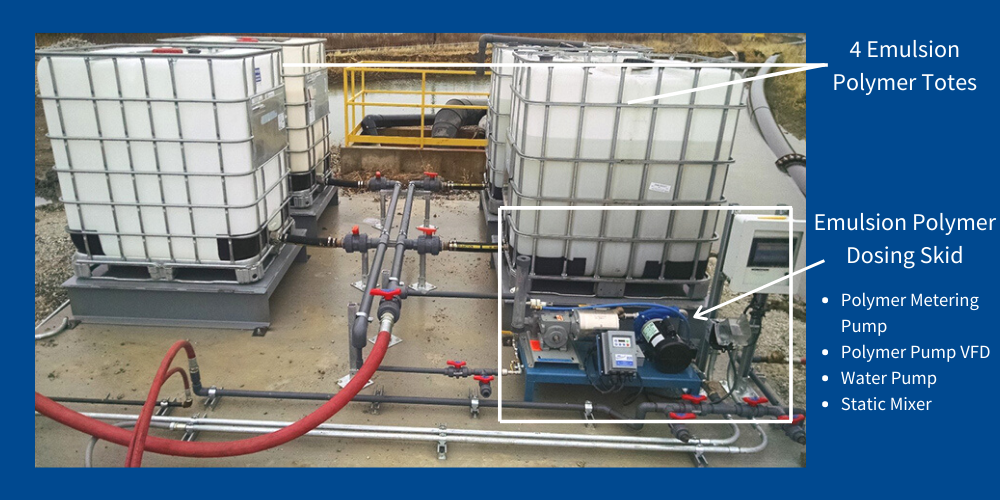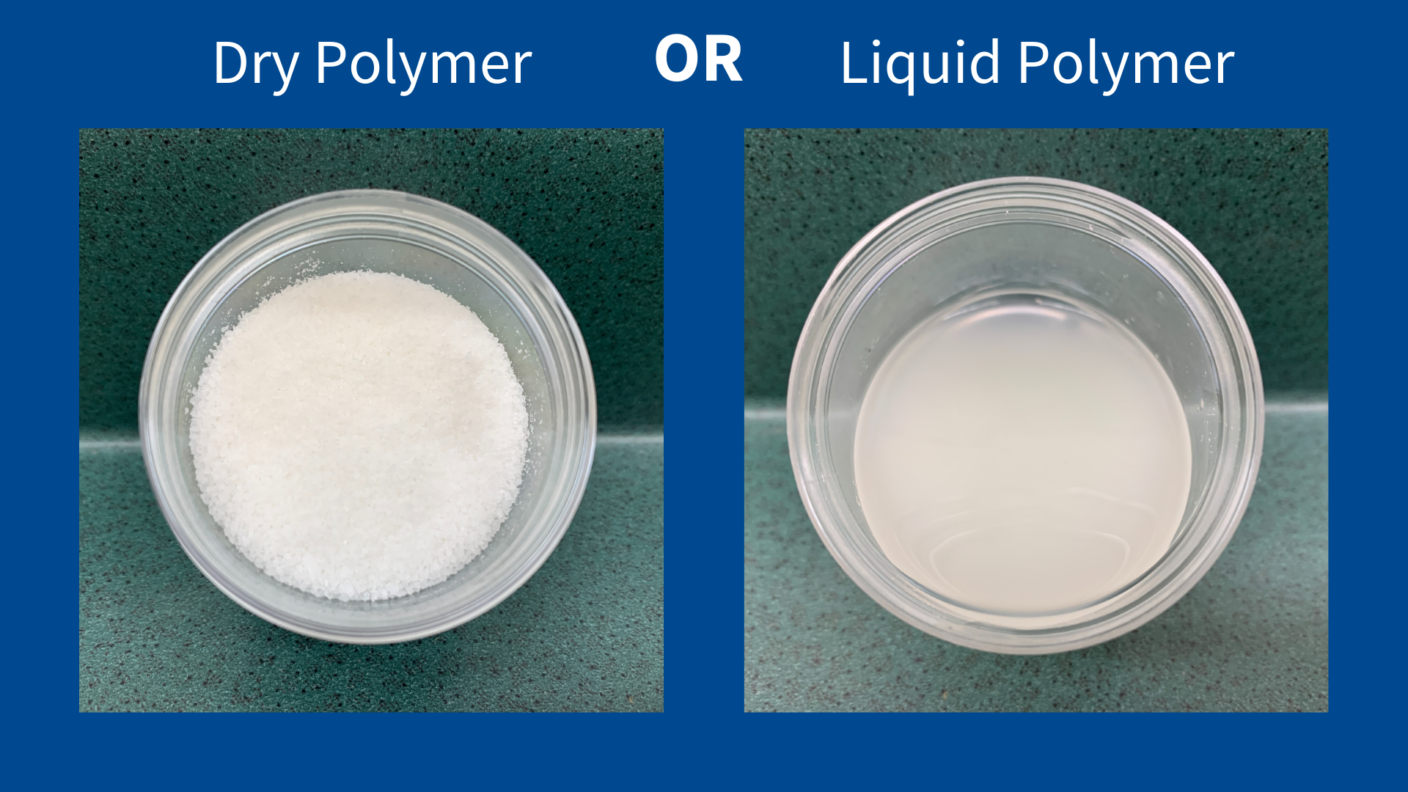Polymers are an important part of wastewater treatment because they help separate solids from liquids through flocculation. They’re a chemical compound that comes as a dry granular polymer or an emulsion polymer, also known as a liquid polymer. Dry & emulsion polymers have different characteristics and handling requirements that users need to consider. This post will discuss the pros and cons of each polymer type.
When deciding whether to use dry or emulsion polymers, it is crucial to consider several factors. These include the dosing equipment’s capital cost, the amount of polymer an application requires, whether a performance gap exists, the operator attention necessary, and the shelf life of polymer.

Capital Costs
Using dry polymer involves make-down and dosing systems that have a higher upfront cost. This cost is due to the tanks and components required to mix and age the chemistry. The powdered or granular dry polymer must be accurately mixed with water and given time to age or “activate.” The mixing is typically achieved through mechanical “prop” style mixers and/or hydraulic shearing via pressurized water streams. The dry polymer must be aged for a minimum of 60 minutes before it’s injected into the wastewater or “process.” Without appropriate aging time, the polymer will not be fully activated, and efficiency is lost.
Emulsion polymers require far less aging time and components to “activate” before being introduced to the waste or process water. The equipment required typically consists of a pump to meter out the polymer, a pump supplying dilution water, and a static mixer to combine the two before it is introduced to the process. The solution is generally “aged” in the line as it makes its way to the dosing location. Due to the lack of aging tanks and mixing equipment, emulsion polymer systems are significantly less expensive than dry polymer make-down systems.

Polymer Consumption
Many applications that require a moderate to a high amount of polymer consumption make fiscal sense to use dry polymer. The return on investment of these systems can often be a matter of months, depending on the polymer chemistry and consumption. Over time, the initial savings found in buying a smaller emulsion polymer dosing system is often counteracted by the increased cost of emulsion polymers themselves. For users treating a flowrate of 1500 GPM or more, eight or more months a year, dry polymers make the most fiscal sense.
Emulsion polymers are approximately 30% active chemistry, whereas dry polymers are typically +90% active chemistry. It is similar to buying bottles of a liquid drink vs. a powdered concentrate and making it yourself. The remaining +70% of ingredients in emulsion polymer are emulsifying agents and surfactants.
The higher shipping costs and lower efficiency of emulsion polymer make dry polymer the preferred option. However, emulsion polymers can be an excellent option for applications with relatively low polymer consumption, spatial constraints, and/or limited operators available.
Polymer Performance (Liquid/Solid Separation)
Dry and emulsion polymers help separate solids from liquids and increase material dewatering. Metrics of polymer performance include settling velocity, mud compaction, and water clarity. Jar tests are used to determine the best dry or emulsion polymer chemistry in a company’s waste or process water sample. Jar testing offers a controlled comparison to determine and quantify these variables.
Many polymer providers offer jar testing of process water samples. This allows an opportunity to see how rapidly the polymer can settle the solids from process water and provides valuable data on the chemistry’s anticipated consumption and cost. These jar or “bench” tests often include side by side comparisons of a provider’s top-performing emulsion and dry polymers or flocculants. These tests provide valuable information and help users save money when deciding between dry and emulsion polymers.
Operator Attention for Polymer Systems
The amount of operator attention a polymer system requires varies considerably depending on how much chemistry is consumed, whether it is dry or emulsion, and the unit’s design and manufacturer.
Typically, dry polymer make-down systems require more attention as the operator is responsible for ensuring dry polymer is in the hopper and that the make-down process is functioning correctly. Dry polymer often comes in 55 lb bags that are manually loaded into a hopper that feeds the material into the mixing tank. 1650 lb “Big Bags” or “Super Sacks” of a dry polymer can also be suspended above systems in high consumption applications to reduce loading frequency.

On the other hand, emulsion polymer systems require less attention due to their simpler operation and minimal components. Emulsion polymers are often pumped from 2300 lb (275 gallon) totes, 460 lb (50 gallon) drums, or even 42 lb (5 gallon) buckets. Polymer pumps connect directly to the liquid polymer containers for easy installation. Plus, because the liquid polymer consumption rate is known by the operator they can check the containers on a regular schedule. Often totes are used in industrial applications. Due to the opacity of the container, operators often use permanent markers to note the daily consumption on the side of the tote in order to track chemical use and identify any anomalies.

Polymer Shelf Life
Shelf life between dry and emulsion polymer is another important consideration. As long as it is kept away from moisture, the dry polymer remains active for years, whereas emulsion polymers have a shelf life of 9-12 months.
A polymer provider should work with clients to set up an appropriate shipping schedule. For instance, North American aggregate producers may have seasonal shutdowns and don’t want unused emulsion polymer wasted. An experienced polymer provider understands a client’s polymer consumption rate and will create a shipping schedule to minimize waste.
What’s Best For You?
It depends. There are many factors to weigh when deciding between dry and emulsion polymers. Both forms of flocculating chemistry have their pros and cons and will have varying impacts on different applications. A helpful place to begin is speaking with an experienced application engineer who can guide you through the process of polymer selection, preparation, and dosing. Equipped with a sample of the process water, knowledge of the water flowrate, and the plant’s operating hours, the engineer will be able to make equipment and chemistry recommendations and estimate chemistry consumption/cost.



